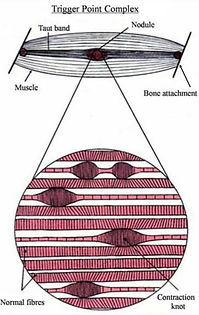
Chorlton Osteopathic Clinic
Osteopathy, Acupuncture, Theraflex
Acupuncture

I practice Western Medical Acupuncture.
In terms of the needles, points and technique, this is similar to 'Traditional Chinese Acupuncture' but placement is according to modern medical theory and applied anatomy, rather than the meridian system.
The traditional system encompasses a wealth of empirical experience, and modern research provides good scientific reasons for its efficacy. Western Medical Acupuncture seeks to incorporate the wisdom and therapeutic benefits of Traditional Chinese Acupuncture into a modern philosophical framework.
The therapeutic effects of acupuncture can be divided into four categories:-
Pain ........................Analgesia
Injury........................Stimulate healing
Contracted muscle.... Relaxation
Health disharmony..... Rebalance

PAIN
Needle stimulation can give pain relief in a number of different ways. Since the 1970s there has been an increasing body of research explaining how and why needle stimulation is effective in the treatment of pain.
INJURY
Persistent pain may also suggest that continuous inflammation is present due to ineffective or abnormal healing. The condition may have become trapped into a vicious cycle of poor quality healing, mal-adaptation and chronic strain. Needling can produce a very accurate, intense mechanical stimulation to the target tissue. This can be to some depth if required, but with no disruption to the surrounding tissue. As such it can be a potent activator to the healing process, which is sometimes necessary to escape from this vicious cycle.
Acupuncture may therefore share similarities with Prolotherapy but without the injection of irritants.
TRIGGER POINTS
Injuries or postural strain can often lead to the formation of trigger points (see diagram). These are localized areas of irritability within a muscle characterized by (a) Local tenderness, often with referred pain extending some distance from the source and (b) Abnormal contraction of some muscle fibres that are no longer in synchrony with the surrounding muscle.
By accurately inserting a needle into the trigger point it is possible to recalibrate the abnormal motor control of these muscle fibres so that they can return to a normal resting tone.

IMBALANCE
Acupuncture can also be used for the treatment of conditions that involve sensitivity of the central nervous system. By tapping into self-regulatory systems of the body, acupuncture can stimulate re-regulation towards a better state of balance.
Conditions which respond to treatment include: insomnia, chronic fatigue syndrome, fibromyalgia syndrome, irritable bowel syndrome, irritable bladder/interstitial cystitis, tension headache, migraine, temporomandibular disorders, sinusitis, restless leg syndrome, primary dysmenorrhea, Sjogren’s disease.


